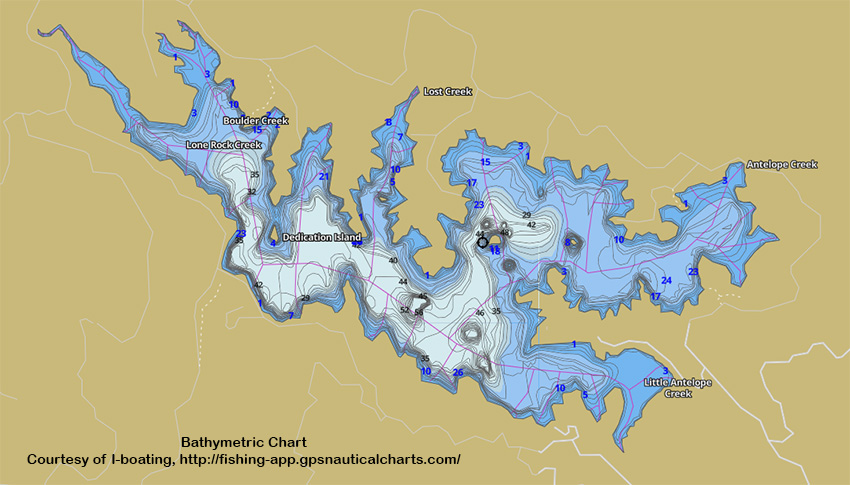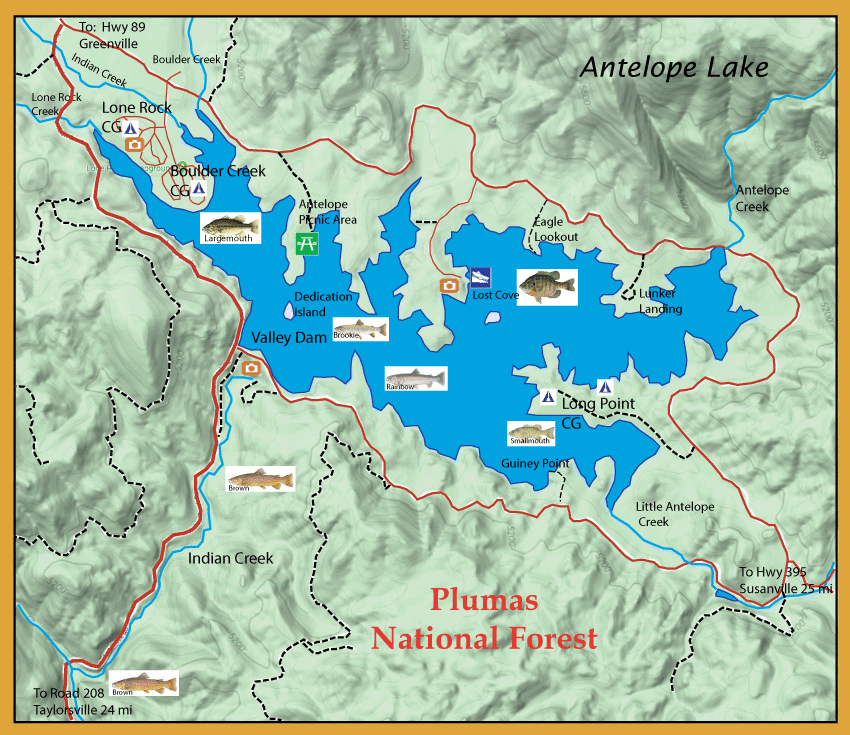 |
Directions:  From Greenville, on Hwy 89; go South 5 miles to Beckwourth Greenville Rd. Turn East, go 16 miles to Indian Creek Road, Turn North, go 10 miles to the Lake. Located 30 miles northeast of Taylorsville on the Genesee-Antelope Lake Road, or from Janesville take County Road 208 for 4 miles, FS road 28N01 for 9 miles, turn right on FS road 28N03 for 2 miles. Supplies including groceries, ice, bait, and souvenirs are available from Memorial Day - Labor Day. Antelope Picnic area has a paved road with restroom facilities. Day-use charge of $10.00 per vehicle. Guiney Point is a well-maintained dirt road with restroom facilities. No charge. From Greenville, on Hwy 89; go South 5 miles to Beckwourth Greenville Rd. Turn East, go 16 miles to Indian Creek Road, Turn North, go 10 miles to the Lake. Located 30 miles northeast of Taylorsville on the Genesee-Antelope Lake Road, or from Janesville take County Road 208 for 4 miles, FS road 28N01 for 9 miles, turn right on FS road 28N03 for 2 miles. Supplies including groceries, ice, bait, and souvenirs are available from Memorial Day - Labor Day. Antelope Picnic area has a paved road with restroom facilities. Day-use charge of $10.00 per vehicle. Guiney Point is a well-maintained dirt road with restroom facilities. No charge.
|
| |
Notes:
 Antelope Lake is at 5,002 feet elevation. The lake covers 930 acres with over 15 miles of shoreline with a maximum depth of 63 feet. It was created in 1964 with an earthen dam spanning Indian Creek. The lake is owned by the State of California , is part of the State Water Project and it was created primarily for recreational use. Four campgrounds are available. There is access at Guiney Point, Lunker Landing and Eagle Lookout. Antelope is primarily a warmwater lake due to the panfish, bullheads, and bass that compete against the trout. It has been poisoned numerous times by Fish and Game to reduce the warmwater species, without success. The lake has a good population of smallmouth and largemouth Bass. It is still planted heavily with Eagle Lake Rainbows and Brookies. The lake also contains Kokanee Salmon and Browns. Weedbeds line the shore so it is difficult to wade. Float Tubing would be best. Work just outside the weedbeds using a sink-tip or full sink line. Spring and Fall are the most popular times to fish this lake for trout as the water is cool and the trout are feeding around the weedbeds. Damsel Nymph patterns, Callibaetis Nymphs, and midges are popular in the Spring. Woolly Buggers and small baitfish patterns work well in the Fall. The inlets of Antelope Lake are Lone Rock Creek, Boulder Creek, Lost Creek, Antelope Creek, and Little Antelope Creek. These inlets provide good fishing areas. From a float tube, your best access sites are Antelope Picnic area, Lunker Landing, and Guiney Point. Antelope Picnic area and Lunker Landing have a somewhat shallower depth of less than 20 feet and the smallmouth and largemouth bass are more numerous in this area. The Eagle Lake trout tend to hang out in deeper waters near Guiney Point. Fish this area with a sinking line and a size 8-10 Woolly Bugger or Balanced Leech and a slow troll from the float tube. You want to get down to about 15 feet. Fly Fishing guide, Lance Gray wrote a fine article about Antelope Lake in the October 2023 edition of California Fly Fisher. This may be the last edition that Richard Anderson will publish. Our congratulations to Richard and all of the staff writers who have put together this great magazine since 1992. It has been the source of much of the information within this website.
Antelope Lake is at 5,002 feet elevation. The lake covers 930 acres with over 15 miles of shoreline with a maximum depth of 63 feet. It was created in 1964 with an earthen dam spanning Indian Creek. The lake is owned by the State of California , is part of the State Water Project and it was created primarily for recreational use. Four campgrounds are available. There is access at Guiney Point, Lunker Landing and Eagle Lookout. Antelope is primarily a warmwater lake due to the panfish, bullheads, and bass that compete against the trout. It has been poisoned numerous times by Fish and Game to reduce the warmwater species, without success. The lake has a good population of smallmouth and largemouth Bass. It is still planted heavily with Eagle Lake Rainbows and Brookies. The lake also contains Kokanee Salmon and Browns. Weedbeds line the shore so it is difficult to wade. Float Tubing would be best. Work just outside the weedbeds using a sink-tip or full sink line. Spring and Fall are the most popular times to fish this lake for trout as the water is cool and the trout are feeding around the weedbeds. Damsel Nymph patterns, Callibaetis Nymphs, and midges are popular in the Spring. Woolly Buggers and small baitfish patterns work well in the Fall. The inlets of Antelope Lake are Lone Rock Creek, Boulder Creek, Lost Creek, Antelope Creek, and Little Antelope Creek. These inlets provide good fishing areas. From a float tube, your best access sites are Antelope Picnic area, Lunker Landing, and Guiney Point. Antelope Picnic area and Lunker Landing have a somewhat shallower depth of less than 20 feet and the smallmouth and largemouth bass are more numerous in this area. The Eagle Lake trout tend to hang out in deeper waters near Guiney Point. Fish this area with a sinking line and a size 8-10 Woolly Bugger or Balanced Leech and a slow troll from the float tube. You want to get down to about 15 feet. Fly Fishing guide, Lance Gray wrote a fine article about Antelope Lake in the October 2023 edition of California Fly Fisher. This may be the last edition that Richard Anderson will publish. Our congratulations to Richard and all of the staff writers who have put together this great magazine since 1992. It has been the source of much of the information within this website.
Indian Creek is full of brown trout. The Indian Creek Road follows the creek up to Antelope Lake. This gives you about 5 miles of easily accessed stream. The creek is best fished during the Spring when Antelope Lake has stopped spilling over. During the summer there are hatches of Yellow stones, tan caddisflies, and pale morning duns.

|
| Fishing Regulations (Effective March 1st, 2021)
Antelope Lake:
Open all year. No restrictions. 5 fish limit. Ten in Possession
Antelope Lake Tributaries
Saturday preceding Memorial Day through September 30th. 5 trout, no gear restrictions. Summer fishing only to protect Spring and Fall Spawning.
|


